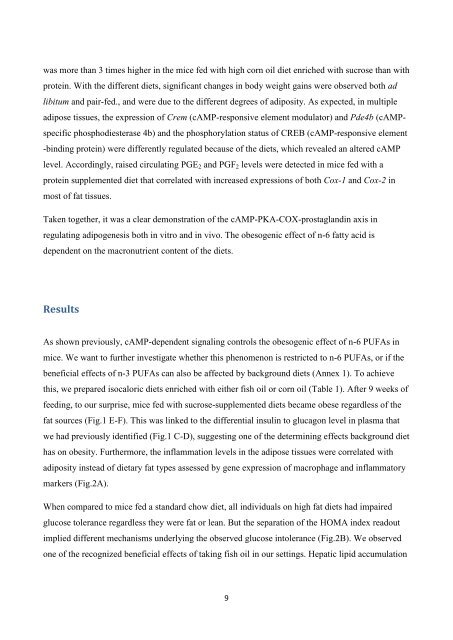The obesogenic effects of polyunsaturated fatty acids are dependent ...
The obesogenic effects of polyunsaturated fatty acids are dependent ...
The obesogenic effects of polyunsaturated fatty acids are dependent ...
Create successful ePaper yourself
Turn your PDF publications into a flip-book with our unique Google optimized e-Paper software.
was more than 3 times higher in the mice fed with high corn oil diet enriched with sucrose than with<br />
protein. With the different diets, significant changes in body weight gains were observed both ad<br />
libitum and pair-fed., and were due to the different degrees <strong>of</strong> adiposity. As expected, in multiple<br />
adipose tissues, the expression <strong>of</strong> Crem (cAMP-responsive element modulator) and Pde4b (cAMPspecific<br />
phosphodiesterase 4b) and the phosphorylation status <strong>of</strong> CREB (cAMP-responsive element<br />
-binding protein) were differently regulated because <strong>of</strong> the diets, which revealed an altered cAMP<br />
level. Accordingly, raised circulating PGE 2 and PGF 2 levels were detected in mice fed with a<br />
protein supplemented diet that correlated with increased expressions <strong>of</strong> both Cox-1 and Cox-2 in<br />
most <strong>of</strong> fat tissues.<br />
Taken together, it was a clear demonstration <strong>of</strong> the cAMP-PKA-COX-prostaglandin axis in<br />
regulating adipogenesis both in vitro and in vivo. <strong>The</strong> <strong>obesogenic</strong> effect <strong>of</strong> n-6 <strong>fatty</strong> acid is<br />
<strong>dependent</strong> on the macronutrient content <strong>of</strong> the diets.<br />
Results<br />
As shown previously, cAMP-<strong>dependent</strong> signaling controls the <strong>obesogenic</strong> effect <strong>of</strong> n-6 PUFAs in<br />
mice. We want to further investigate whether this phenomenon is restricted to n-6 PUFAs, or if the<br />
beneficial <strong>effects</strong> <strong>of</strong> n-3 PUFAs can also be affected by background diets (Annex 1). To achieve<br />
this, we prep<strong>are</strong>d isocaloric diets enriched with either fish oil or corn oil (Table 1). After 9 weeks <strong>of</strong><br />
feeding, to our surprise, mice fed with sucrose-supplemented diets became obese regardless <strong>of</strong> the<br />
fat sources (Fig.1 E-F). This was linked to the differential insulin to glucagon level in plasma that<br />
we had previously identified (Fig.1 C-D), suggesting one <strong>of</strong> the determining <strong>effects</strong> background diet<br />
has on obesity. Furthermore, the inflammation levels in the adipose tissues were correlated with<br />
adiposity instead <strong>of</strong> dietary fat types assessed by gene expression <strong>of</strong> macrophage and inflammatory<br />
markers (Fig.2A).<br />
When comp<strong>are</strong>d to mice fed a standard chow diet, all individuals on high fat diets had impaired<br />
glucose tolerance regardless they were fat or lean. But the separation <strong>of</strong> the HOMA index readout<br />
implied different mechanisms underlying the observed glucose intolerance (Fig.2B). We observed<br />
one <strong>of</strong> the recognized beneficial <strong>effects</strong> <strong>of</strong> taking fish oil in our settings. Hepatic lipid accumulation<br />
9
















